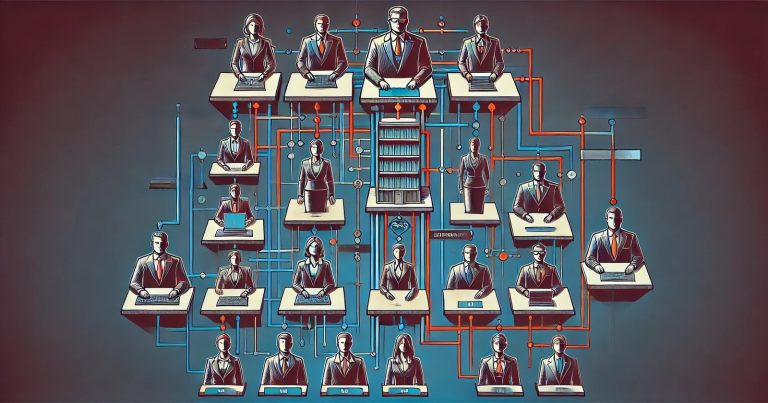The concept of organization refers to the systematic arrangement of people, resources, and tasks to achieve certain goals in the most efficient way possible. Organization provides a well-defined framework for operations in terms of roles, responsibilities, and authority, hence the smoothness of operations. Coordination, resource optimization, and productivity enhancement are some of the benefits organizations have in any kind of business, government, or social institution to maintain order and achieve set objectives. Understanding the concept of organization is important for effective management and long-term success.
What is Organization?
An organization is a cooperative group and works toward the accomplishment of common goals or objectives. Organizations can comprise any enterprise, a non-profit organization, an establishment by the government, or even a community organization. They usually have set roles, responsibilities, and hierarchies that make it easy to coordinate action and decide issues. The category ranges from the most informal, smallest group to the largest multinational corporation, crossing every part of human society.
Organizing involves defining and classifying the enterprise’s activities and establishing relationships of authority. In the function of organizing, the manager determines, departmentalizes, and assigns activities such that they are executed in a most effective way.
Features of Organization
The features of organization indicate its structure, functioning, and overall approach in achieving the set objectives. These essential qualities separate one organization from another and ensure everything is fine.
- Division of work: Organization mainly involves division among several individuals or groups. This increases the specialisation of tasks, increasing efficiency and productivity. For example, in a hospital setting, the doctors and nurses have specific roles to play the same way as people in the administrative offices, yet their end always cares for patients.
- Authority Hierarchy: Organizations, big or small, are followed by a hierarchy or structure indicating who reports to whom. Decision-making processes are more transparent, and people are accountable. With the hierarchical structure, the manager can assign work and monitor the performance of subordinates.
- Coordination of Activities: Coordination among the various departments or teams is another feature of an organization. Coordination is that attribute which prevents confusion and ensures all parts of the organization work for a common objective.
- Common goals: Organization exists to achieve particular objectives. Objectives can be anything, but they constitute the main aim that organization members strive to achieve. All efforts will be directed towards common goals in a business, profit generation, schools, and education.
- Formal rules and procedures: An organization typically has formal rules and procedures that maintain order and consistency. Formal rules guide employee behaviour and promote fairness and organizational transparency.
- Resources Management: Effective management of resources—be it human, financial, or technological is another feature of an organization. Proper resource allocation ensures the organization has what it needs to operate and grow effectively.
- Communication Channels: Communication is the lifeline of any organization. The communication channels between departments and teams should be crystal clear to convey information correctly and on time.
Types of Organization
There are several types of organizations, each with its structure and way of operating. These types help businesses decide how they want to divide tasks and responsibilities.
Functional Organization
Under a functional organization, employees are assembled according to the function or expertise the firm needs. Separate departments such as marketing, finance, and operations have managers responsible for running all activities within that department.
- Benefits: Division of tasks on expertise. Clarity of what falls within the sphere of a given department. Rational use of each function’s resources.
- Examples: A manufacturing firm with a different production, finance, and marketing department.
Divisional Organization
In a divisional organization, the business is divided into semi-autonomous divisions, each responsible for its own goods, services, or regions. Each division operates like a company but is still part of the larger organization.
- Benefits: Concentrating all divisions on a specific goal Encourages changeability and innovativeness from the divisions or units. End.
- Examples: A global company with various business segments for various geographical regions such as North America, Europe, and Asia.
Matrix Organization
A matrix is a combination of functional and divisional structures. Employees report to the functional manager and the project or product manager in this structure. This is designed to increase flexibility and communication between different parts of the organization.
- Benefits: Interdepartmental collaboration is increased. Flexibility in accommodating new projects or priorities. Better utilization of resources in multiple projects.
- Examples: A technology company where developers work on various product teams but also report to functional managers for specific technical skills.
Flat Organization
A flat organization has minimal levels in a hierarchy, meaning employees have much closer access to top management, which fosters open communication and high autonomy levels.
- Benefits: Stimulates innovation and creativity. Minimizes cost for management. Makes faster decisions.
- Examples: Startups or small businesses with fewer layers of management.
Importance of Organization
The importance of organization lies in how it structures its resources and people to make operations smooth and productive. Efficient, well-organized businesses and institutions are known to have efficient communication and sound decision-making.
- Clear Role Definition: Employees know what to do; therefore, there would be less error and confusion. This also contributes to job satisfaction because employees know what they do for the organization.
- Better Coordination: Proper organizing structure ensures better coordination between departments or teams. Teams can work smoothly toward common objectives or goals without overlapping tasks or confusion.
- Improved Communication: An explicitly defined hierarchic arrangement of an organizational setup encourages decision-making to become very rapid in communication, resolves problems, and facilitates fast information flow across the organization.
- Effective Resource Management: Proper organization ensures that resources, money, and people are used productively. Such an organization can save on cost and increase productivity by eliminating waste and optimizing workflows.
- Achievement of Goals: An organized structure enables the business or organization to concentrate on activities to achieve its goals in a systematized manner. It easily disintegrates big objectives into small, easy-to-manage work that can be monitored and completed quickly.
Concept of Organization FAQs
What is the concept of organization?
Organization is the act of arranging people, tasks, and resources for the accomplishment of specific goals.
Why is business important for an organization?
Business organization is essential in ensuring efficient management of resources, clear roles, and effective communication, hence increased productivity and growth.
What are the types of organization?
Functional, divisional, matrix, and flat structures provide different benefits according to the business needs.
What are features of informal organizations?
Features of informal organizations are elastic communications, social networks, and relationships that are not spelt out by roles or rules that tell people what to do.
What are the steps of the process of organization?
Organizational Process Steps: Observe the purpose, divide jobs, assign authority, and coordinate activities.


